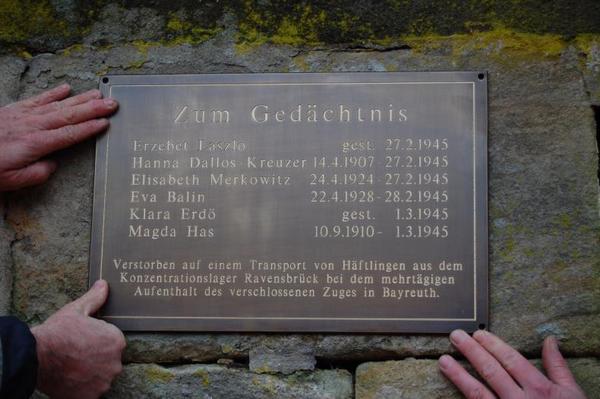We now know what became of the bodies of Hanna Dallas and five of her companions, disembarked from a convoy of prisoners on the morning of the 1er March 1945 at Bayreuth station. The train had been parked in this town for several days, blocked in its progress by Allied bombing.

In memory of Erzebet Laszlo, Hanna Dallos-Kreutzer*, Elisabeth Merkowitz**, Eva Balin, Klara Erdö***, Magda Has, who died in a convoy of female prisoners from Ravensbrück, during a stop of several days in the lead-lined carriages in Bayreuth. Photo: Stadt Bayreuth
The bodies were placed in paper bags and buried anonymously in Bayreuth's municipal cemetery. Research carried out in 2013 by Dr Sylvia Habermann, Director of the Bayreuth Historical Museum, led to the women finally being given their names back, and a small group of local citizens**** to have a plaque placed in the cemetery. On 27 January 2015, seventy years later, they received an official tribute from Germany on the national day of remembrance for the victims of the Nazi dictatorship.
Eva Danos tells in The last convoy the long ordeal of hundreds of Jewish women, including her friends Lili and Hanna with whom she had been arrested in Budapest. Leaving Ravensbrück on February 17, the train was to deliver the prisoners to Burgau, an annex of the Dachau camp, where these women were expected to work in a Messerschmitt factory. It will take sixteen days to cross Germany.
Hanna's Last Night
“The disarray of the night prevented me from watching over Hanna. From time to time, I heard her sigh "Oh Joseph… Mom… Dad", but I still did not fear the worst. However, the desolate morning casts its austere light over his corpse. His eyes are wide open, his face bears the scars of death. She lies there barely a step from me, and my heart freezes and paralyzes: this is what has become of the warm Hanna who believed with the fervor of an apostle in the noble nature and the sublime vocation of 'humanity. Hanna who was always looking for the beautiful, the true, the pure, who tried everywhere to find the good, even in what might seem the worst, Hanna had to suffer the ugliest and most degrading end. So theone of the greatest talents of Hungarian graphic art, one of the most gifted poster artists who with her drawings had made our popular art known in England, had to end her life on the miserable floor of a German cattle car. Oh Hanna, dearest Hanna! (…) While cleaning, I lean out of the wagon door. The Germans are removing the bag containing Hanna's body and in silence, I say goodbye to our friend. I read the name of the station: Bayreuth… what an atrocious coincidence: Wagner… Festspiele (Festival)… and Hanna dead. »
Lili, she will be carried away three days later by typhus and his body lowered to Augsburg.
* Hanna Dallos was not born on 14 April, but on 14 June 1907, as Gitta Mallasz points out in the Talking with Angels (p. 291), a week before her.
** Elisabeth Merkowitz is "the dreamy-eyed, idealistic twenty-year-old girl whom Hanna named Puck because of her uncanny resemblance to the little pixie in the Dream of a summer night. » (The last convoy, p. 59)
*** Klara Edö is probably Klara Erdélyi, who left Budapest on the same train as the three friends, was their companion at Ravensbrück and was locked in the same carriage as them. She was also the first to die there.
**** They are Felix Gothart, President of the Jewish Cultural Association, historian Norbert Aas, Dr Sylvia Habermann, Director of the Historical Museum, and Carsten Hillgruber, Social Advisor.
Bayreuth's municipal cemetery is located at Erlanger Strasse, and the plaque can be found on the dividing wall between the new and old cemeteries, but the two graves have unfortunately been replaced by others.
See alsoarticle by Michael Weiser in the Nordbayerischer Kurier, who provided us with the information.
EL/FM


